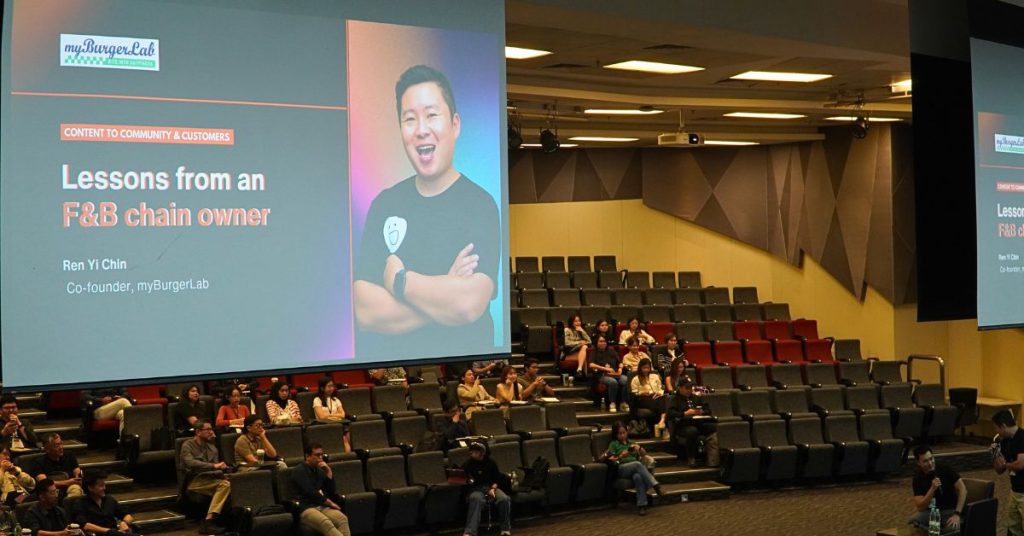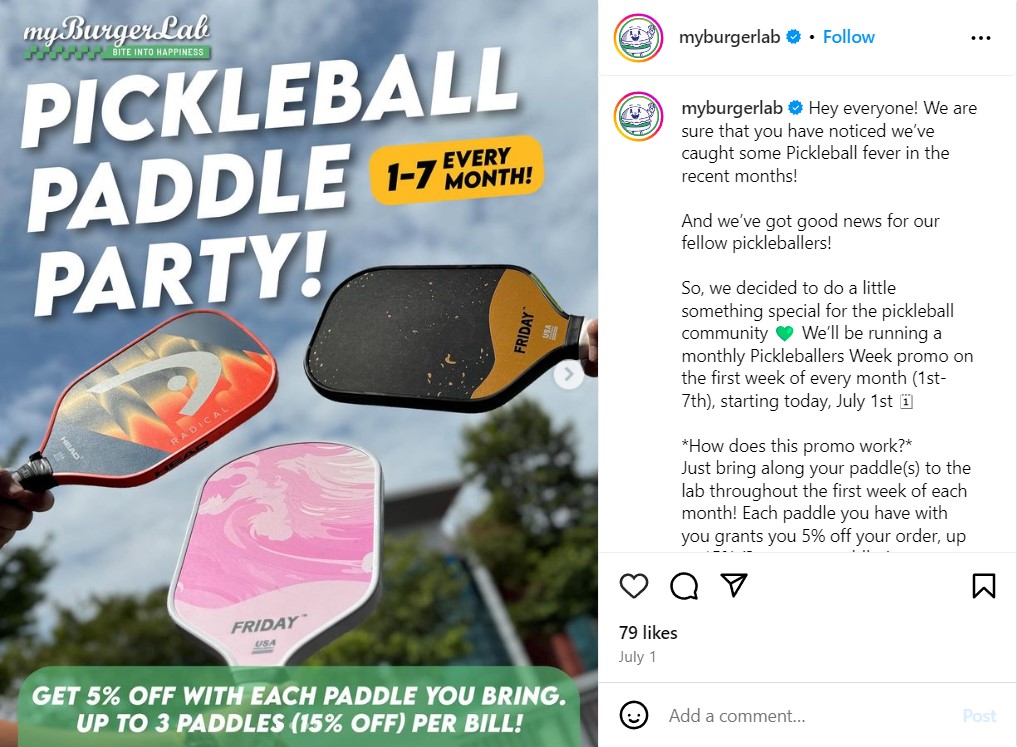myBurgerLab (mBL) is a name that needs no introduction for most Malaysians.
It was founded in 2012 by Chin RenYi, Cheah Chang Ming, and Teoh Wee Kiat. Today, RenYi remains the sole co-founder spearheading the business.
Over his 12 years leading mBL, he has amassed plenty of experience in running a successful brand, including leveraging content marketing.
And thankfully, he’s not one to gatekeep.
At the recent Underdog Content Conference ‘24 by Daily CMO—a platform to help anyone become better marketers—RenYi took the stage to share how mBL does successful content marketing.

But first, what’s content marketing VS paid ads?
Briefly, paid ads are those ads (marked as sponsored) you’ll usually see on your social media homepage.
Some features of paid ads are that they’re hard sells, focused on pushing a specific product or service, and typically bring in fast but short-term results.
In comparison, content marketing has a more soft-sell approach, telling the story of the brand or sharing parts of its journey.
It’s said to be more useful for achieving a brand’s long-term goals, providing longer-lasting results (such as building customer trust, brand reputation, and more). Content marketing can be organic, or boosted to extend its reach.
If done right, it’s a strong tool that can grow brand awareness, even without paying a single cent to the social media platforms.
| Paid ads | Content marketing | |
| Purpose | Hard sell/push a product/service | Tell the story of a brand, share parts of the journey |
| Pro | Faster results (like sales) | Longer-lasting results (builds customer trust, brand reputation, awareness, and understanding) |
| Con | Short-term results | Results might be slower to achieve |
| Cost | Paid, and could get expensive to achieve desired results on a specific platform | Can be organic (non-paid) or boosted (paid to increase reach), but note that there could be manpower costs as well to have your own content team |
With that, here’s some of RenYi’s advice for content marketing, based on what myBurgerLab practices.
1. Put out whatever content you can
If you’ve been following mBL’s journey from the early days, you’d know that they’ve maintained a strong social media presence.
RenYi’s ethos on running a brand has always been to see it as an opportunity to have fun.
“One of the first few things that I had to fight [about] with my partners at the time, was that we have to use social media in a way whereby it doesn’t feel like it’s corporate, it doesn’t feel like there’s a lot of limitations, and we have to be ourselves and have fun with it.”

He added, “So back in the early days, we shared very openly our recipes, what we were doing, behind the scenes stories. Not so much these days in video format, but more picture format and long text format.”
2. But don’t create content for the sake of creating content
Content without substance won’t do much for your business. There has to be a purpose behind why you’re putting out a piece of content.
Do you want to share a story that happened with the business? Do you want to shout out a new product or service?
Once you know the content’s purpose, you can decide which format will work best, be it a video, poll, text post, etc.
A useful guideline for what kind of content to put out and how frequently you should be doing so is the “hero, hub, and hygiene” strategy.
Hero content refers to big, once-in-a-while campaigns meant to generate buzz and bring in new customers.
Meanwhile, hub content is regular content that’s meant to engage with your existing community and keep them updated with what’s happening with your brand.
Hygiene content is similar to hub but with an increased frequency. Its purpose is to keep your brand relevant, and is typically based on what customers are looking for.
3. Tell your brand story & show what’s behind the scenes
People loooove when a brand gets real and candid about what’s going on behind the scenes. In fact, we recently wrote a whole article about some Malaysian brands who are killing the content marketing game right now.
One of the most popular examples is Grumpy Bagels, who shot to virality even before the business was launched, leading to one-hour queues today (or so we’ve heard).
This was thanks to a series of videos where the founder, Claire, brought her audience along on her journey of renovating a house into the Grumpy Bagels cafe.
People became invested in how the finished cafe would look like, and would share advice for the roadblocks she was facing.
Her content marketing success has been acknowledged by fellow entrepreneurs, RenYi included, who named her as an example during the Underdog Con.

This strategy helps to showcase all the hard work that goes into building your business, and allows people to feel like they’re a part of your journey.
But, say you don’t have the means to do your own content marketing. What then?
4. Work with the professionals
It’s simple advice that rings true for most things in life. If you want to do something but can’t or aren’t willing to put in the time and effort to learn how to do it yourself, then outsource.
You can get an agency to take charge of creating content for your brand, or engage a media publication like Vulcan Post to grow your brand awareness and credibility.
Shameless plug: Reach out to us here if you’d like to see what kind of content marketing we can do for your brand!
5. Include your community, they will start selling things for you naturally
mBL has a great example for this. One burger that’s remained on their menu since 2012 is Vivien’s Husband, a vegetarian burger.
It got its name on the first day mBL was testing its customer reception. A lady had walked in, asking for a vegetarian burger.

She immediately fell in love with it, and asked why it didn’t have a better name that wasn’t… Vege Beta. In return, the mBL team asked if she would like to name it.
Delighted, she said, “Yeah! I want it to be my husband. Vivien’s husband.”
Thus, history was made.
RenYi said that she loved the idea so much that she started bringing her friends every week to try her “husband”.
All this to say, involving your community in parts of your business will naturally lead to them sharing your story and selling your product without much prompting.
6. Don’t underestimate limited-time offerings
Remember the “hero, hub, and hygiene” content strategy? This could fall under either hub or hygiene content, keeping your brand in the limelight and reminding customers of what they’re missing out on.
Take for example how mBL comes up with daring, limited-time offerings every so often, with some examples you might have seen (and tried) being the Katy Perry Burger, the Taukeh Ipoh Burger, and more.
If you’re in an industry where competition is tight, limited-time specials alongside your mainstays could be the not-so-secret recipe to ensuring your brand remains at the top of people’s minds.
7. Associate your brand with a lifestyle that’s currently trending
What do burgers and pickleball have in common? Can’t think of an answer?
That doesn’t mean that you can’t still associate them with one another though. That’s exactly what mBL has been doing.
Pickleball has been all the rage in Malaysia recently, and mBL hopped into the scene with a monthly promo for pickleball players.

They didn’t have to do anything drastic like come up with a pickleball-themed burger or launch a pickleball competition, just to break into the trendy community.
Think outside the box, and you’ll find a solution to connect with the community in a way that’s still true to your brand.
8. Controversy is a form of marketing too, but be careful
Many brands that have made it big are no strangers to controversy, mBL themselves included, such as with their 2020 PR crisis.
ZUS Coffee’s COO, Venon Tian, has even acknowledged that controversy was pivotal in building their brand awareness.
But beware. While controversy can lead to your brand going viral and drive sales momentarily, it could come at the cost of your brand reputation.
As a brand scales, reputation becomes all the more important to protect.
Are there ways to leverage controversy without being in the centre of it then? Absolutely, just see how 14 local brands put their own spin on the viral RM460 burger drama back in 2020.
- Read more about how brands do content marketing here.
- Want to explore content marketing with Vulcan Post? Reach us here!
Featured Image Credit: Daily CMO

